AUDI Q5 2013 Owners Manual
Manufacturer: AUDI, Model Year: 2013, Model line: Q5, Model: AUDI Q5 2013Pages: 316, PDF Size: 78.89 MB
Page 281 of 316
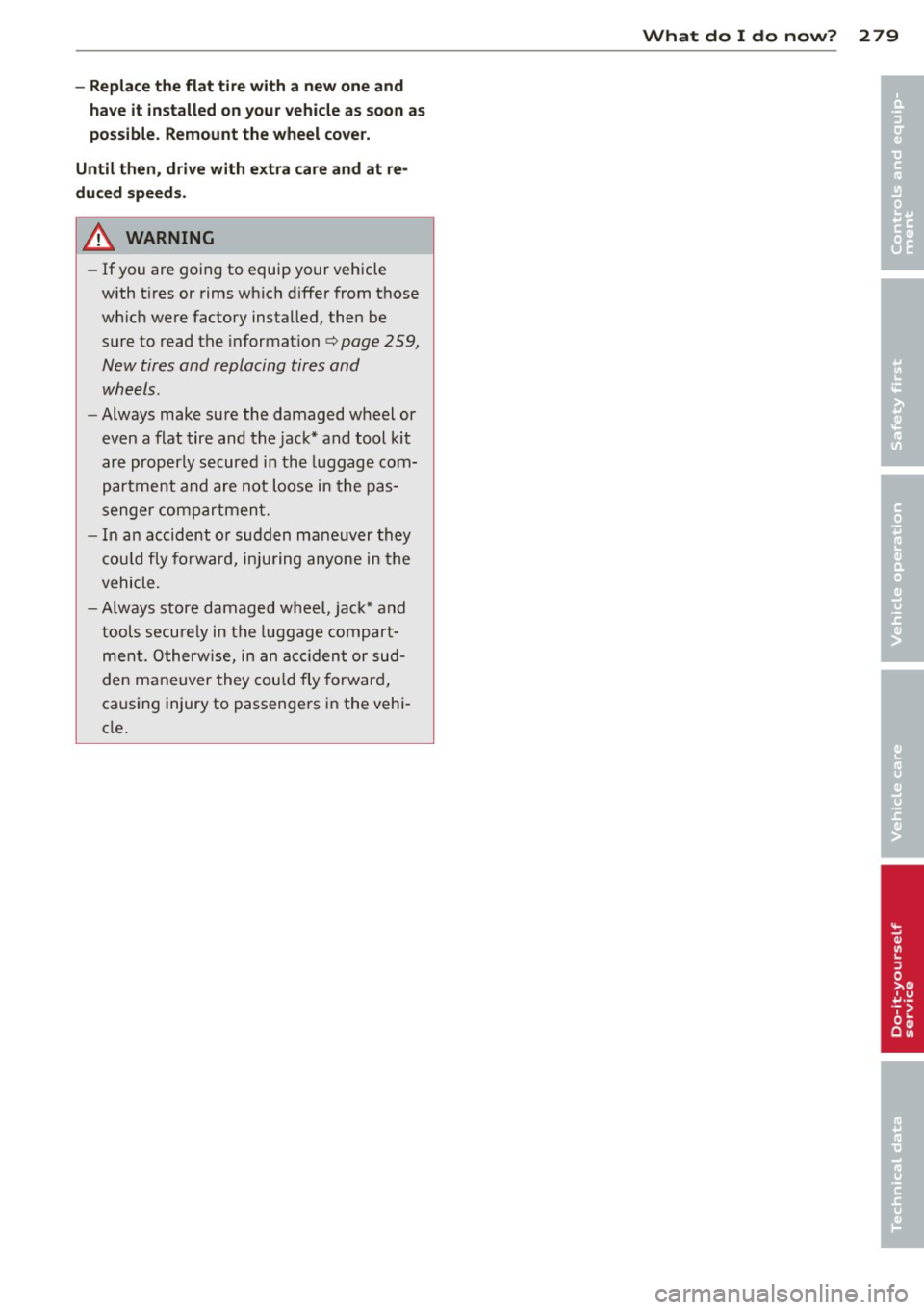
-Replace the flat tire with a new one and
have it installed on your vehicle a s soon as
possible. Remount the wheel co ve r.
U ntil th en, driv e with extr a car e and at re ­
du ced speeds .
~ WARNING
-
-If you are going to equip your vehicle
with t ires or rims wh ich differ from those
wh ich were factory installed, then be
sure to read the informat ion
c:> page 259,
New tires and replacing tires and
wheels.
- Always make sure the damaged wheel or
even a flat tire and the jack * and tool kit
are properly secured in th e luggage com·
partment and are not loose in the pas·
senger compartment.
- In an accident o r sudden maneuver they
c ou ld fly forward, inju ring anyone in the
vehicle .
- Always store damaged w heel, jac k* and
tools secure ly in the luggage compart­
ment. Otherw ise, in an acc iden t or sud­
den maneuver they cou ld fly forward,
causing injury to passenge rs i n the vehi·
cle .
What do I do now? 2 79
‚ÄĘ
‚ÄĘ
Page 282 of 316
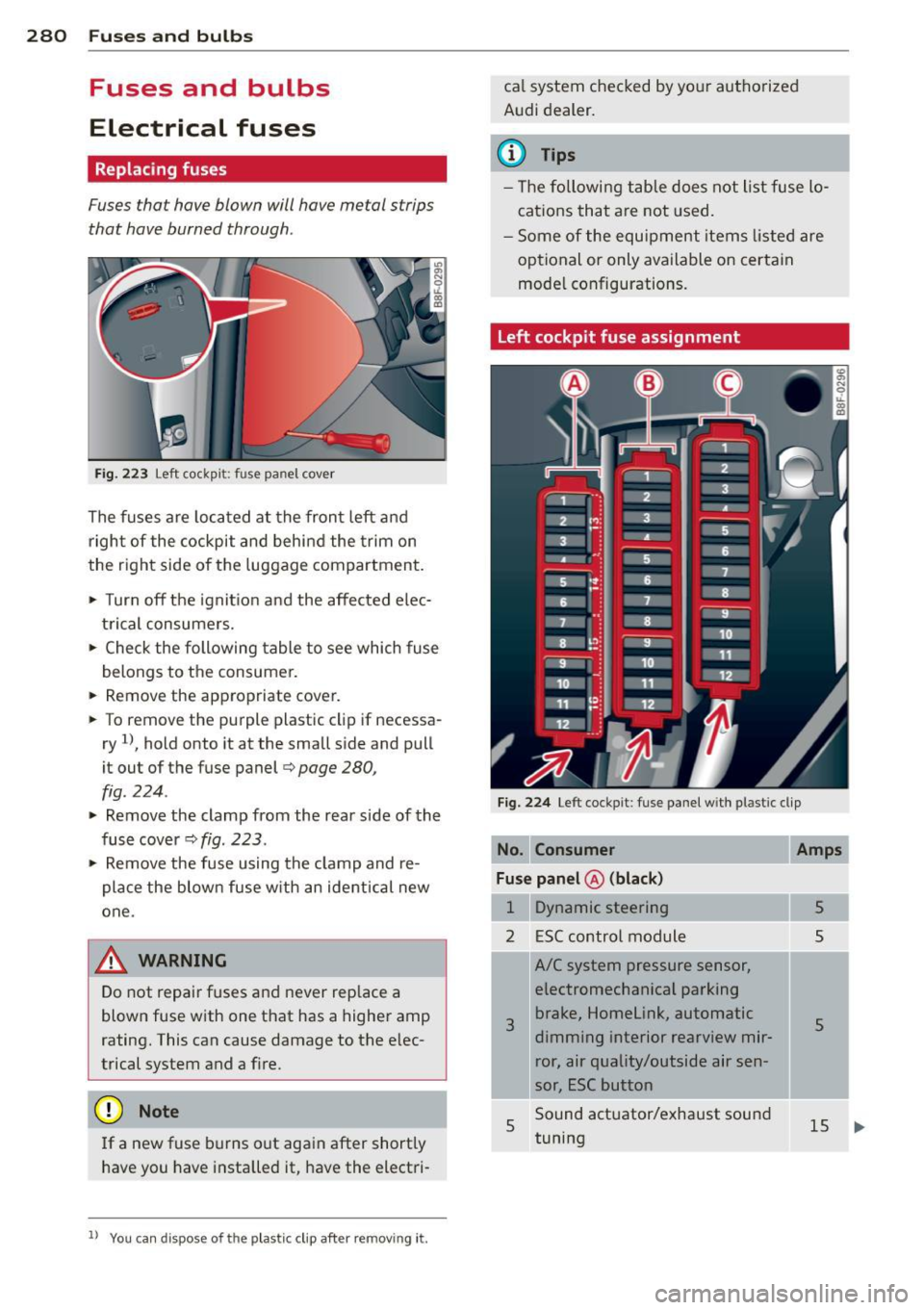
280 Fuses and bulbs
Fuses and bulbs
Electrical fuses
Replacing fuses
Fuses that have blown will have metal strips
that have burned through.
Fig. 223 Left cockp it: fuse panel cove r
The fuses are located at the front left and
right of the cockpit and behind the trim on
the right side of the luggage compartment.
‚ÄĘ Turn off the ignit ion and the affected elec¬≠
trical consumers.
‚ÄĘ Check the following table to see which fuse
belongs to the consumer.
‚ÄĘ Remove the appropriate cover.
~ To remove the purple plastic clip if necessa­
ry
l), hold onto it at the small side and pull
it out of the fuse panel¬Ę
page 280,
fig.
224.
‚ÄĘ Remove the clamp from the rear side of the
fuse cover¬Ę
fig. 223.
‚ÄĘ Remove the fuse using the clamp and re¬≠
place the blown fuse w ith an identical new
one.
.&_ WARNING
-
Do not repair fuses and never replace a
blown fuse with one that has a higher amp
rating. This can cause damage to the e lec­
trical system and a fire.
(D Note
If a new fuse burns out again after shortly
have you have installed it, have the electri-
ll You ca n dispose of the p lastic clip after remov ing it.
ca l system checked by your authorized
Audi dealer.
(D Tips
- T he following table does not list fuse lo­
cations that are not used.
- Some of the equipment items listed are
optional or only available on certain
mode l configurations.
Left cockpit fuse assignment
Fig. 224 Left cockpit : fuse panel with plastic clip
Fuse panel @ (black)
1 Dynamic steering
2 ESC control module
3
5
A/C system pressure sensor,
electromechanical parking
brake, Homelink, automatic
dimming interior rearview mir­
ror, air quality/outside air sen-
sor, ESC button
Sound actuator/exhaust sound
tuning
Amps
s
s
5
15
Page 283 of 316
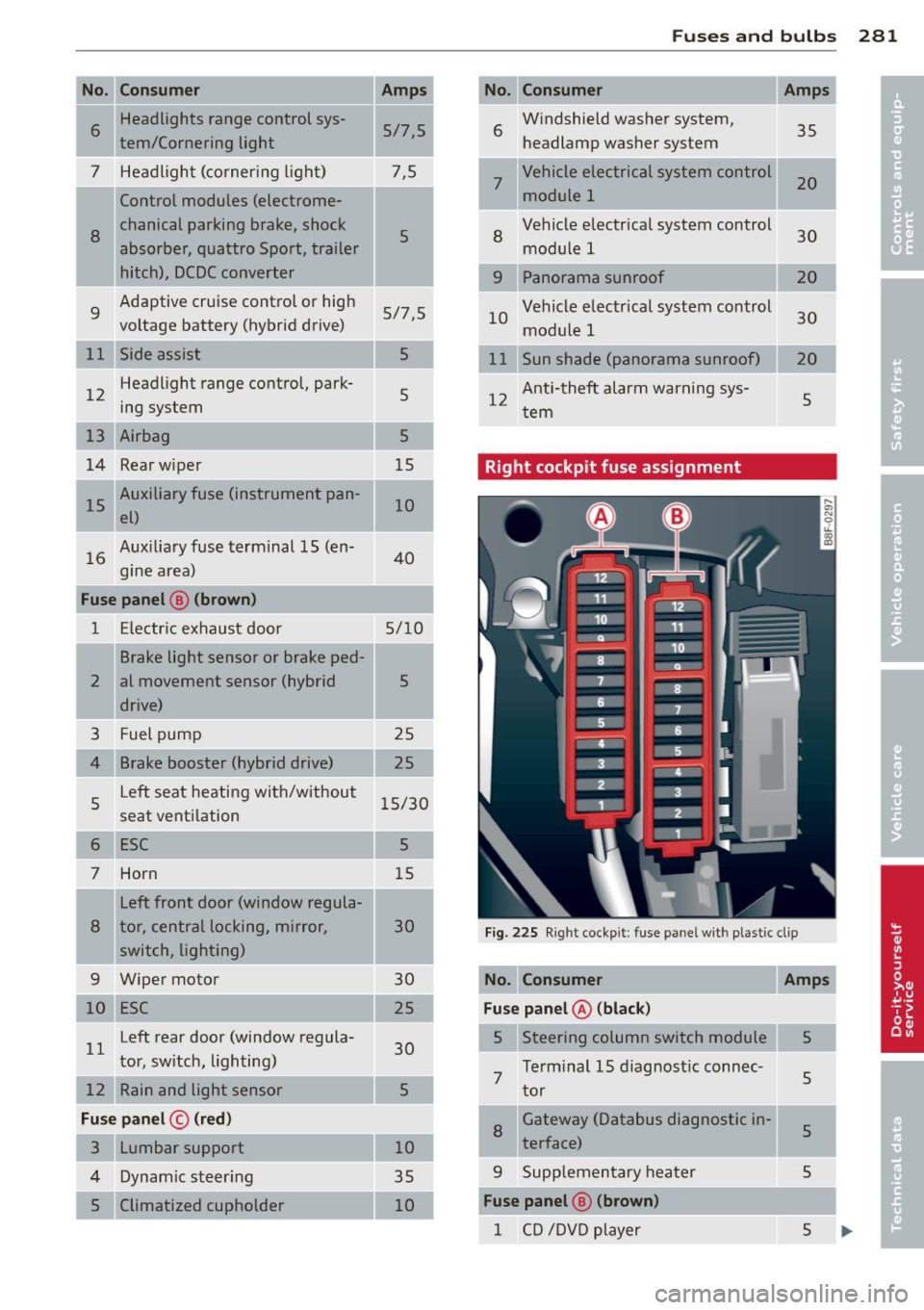
I
I
I
-No. Consumer
6
Headlights range control sys-
tern/Co rnering light
7 Headligh t (corner ing l ight)
Control modules (electrome-
8
chanical parking brake, shock
absorber, quattro Sport, trailer
hitch), DCDC converter
9 Adaptive cruise contro
l or high
voltage battery (hybrid drive)
12 Headlight range contro
l, park­
ing system
13 Airbag
14 Rear wiper
15 Auxiliary fuse (ins
trument pan ­
el)
Auxilia ry fuse terminal 15 (en-
16 gine area)
Fuse panel
@ (brown )
1 E lectric exhaust door
2
3
4
5
6
7 Brake light sensor or brake ped­
al movement sensor (hybrid
drive)
Fuel pump
Brake booster (hybrid drive)
Left seat heating with/without
seat venti
lation
ESC
Horn
Left fron t door (window regula -
8 tor, central locking, mirror,
sw itch, lighting)
-9 Wiper motor
10 ESC
Left rear door (window regula­
l l tor, sw itch, light ing)
12 Rain and light sensor
Fuse panel © (red)
3 Lumbar support
4 Dynam ic ste ering
5 Climatized cupholder
-Amps
5/ 7,5
7,5
5
5/7,5
5
5
5
15
10
40
5/10
5
25
25
1 5/30
5
15
30
30
2 5
30
5
10
35 10
-
Fu se s and bulb s 281
No. Consumer
6 W
indshield washer system,
headlamp washer system 35
7
Vehicle electrical system control
module 1 20
8
Vehicle electrical system control
module 1 30
9 Panorama su
nroof
10 Vehicle elec
trical system control
30
mod ule 1
11 Sun shade (panorama sunroof)
20
12 Anti-theft alarm warning sys-
tern 5
Right cockpit fuse assignment
Fi g. 22 5 Right cockp it : fuse panel wit h plast ic cl ip
No. Consumer Amps
Fuse panel @ (black )
5 Steering column switch module 5
7 Te
rm inal 15 d iagnost ic connec-
tor
5
8 Gateway (Databus diagnostic in-5 terface)
-..
9 Supp
lementary heater 5
Fuse panel @ (brown)
1 CD /D V D p layer 5
Page 284 of 316
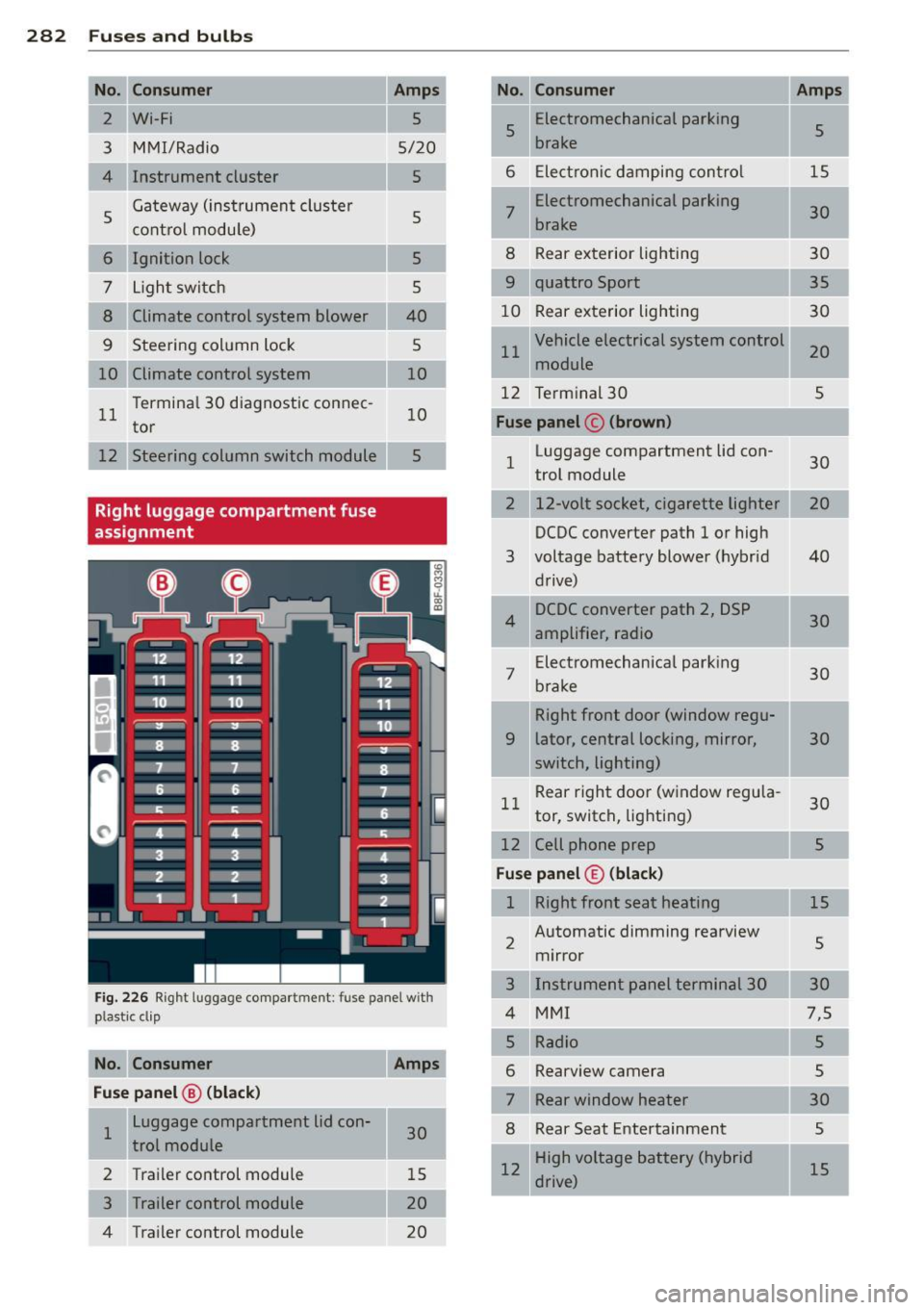
282 Fuses and bulbs
I
-
No. Consumer
2 Wi-Fi
3 MMI/Radio
4 Instrument cluster
5 Gateway (instrument cluster
control
module)
6 Ignition lock
7 Light switch
8 Climate control system blower
9 Steering column lock
10 Climate control system
11 Terminal 30 diagnostic connec-
tor
12 Steering column switch module
Right luggage compartment fuse
assignment
Amps
5
5/20
5
5
5 5
40
5
10
10
5
Fig. 226 Right luggage compartment: fuse panel with
plastic cl ip
No. Consumer Amps
Fuse panel
@ (black)
1 Luggage compartment lid con-
30
trol module
2 Trailer control module 15
3 Trailer control module 20
4 Trailer control module
20
-No. Consumer Amps
5 Electromechanical
parking
5
brake
‚ÄĘ
6 Electronic damping control 15
7 Electromechanical parking
30
brake
8 Rear exterior lighting 30
9 quattro Sport
35
10 Rear exterior lighting 30
11 Vehicle electrical system control
20
module
12 Terminal 30
5
Fuse panel c (brown)
1 Luggage compartment lid con-
30
trol module
2 12-volt socket, cigarette lighter
DCDC converter path 1 or high
3 voltage battery blower (hybrid 40
drive)
4 DCDC
converter path 2, DSP
30
amplifier, radio
7 Electromechanical
parking
30
brake
Right front door (window regu-
9 later, central locking, mirror, 30
switch, lighting)
11 Rear
right door (window regula-
30
tor, switch, lighting)
12 Cell phone prep 5
Fuse panel© (black)
1 Right front seat heating
15
2 Automatic dimming rearview
5
mirror
3 Instrument panel terminal 30
4 MMI 7,5
Rearview camera
Rear window heater
8 Rear Seat Entertainment
12 High voltage battery (hybrid
drive)
Page 285 of 316
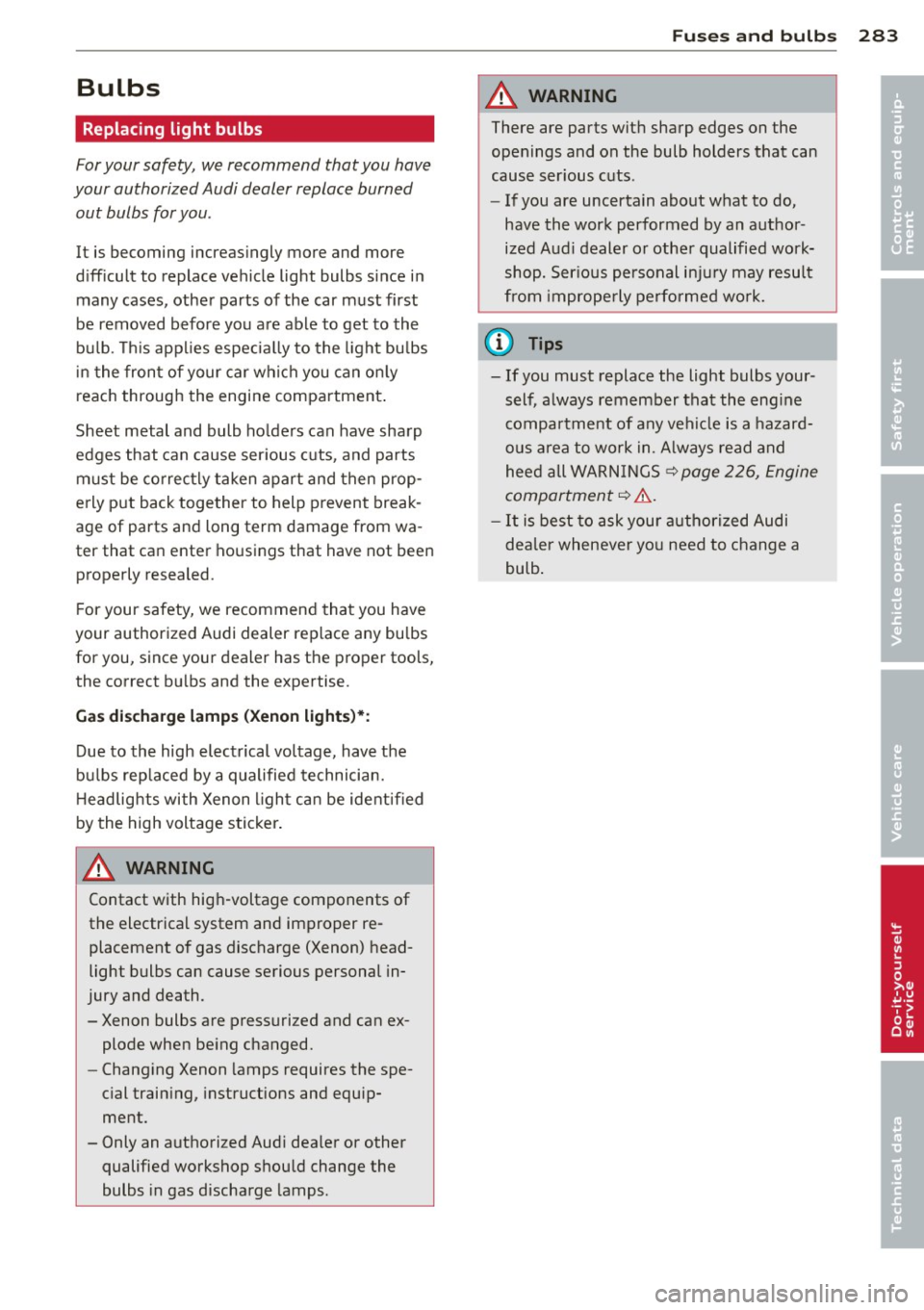
Bulbs
Replacing light bulbs
For your safety, we recommend that you have
your authorized Audi dealer replace burned
out bulbs for you .
It is becoming increasingly more and more
difficult to replace vehicle light bulbs since in many cases, other parts of the car must first
be removed before you are able to get to the
bu lb. This appl ies especially to the light bu lbs
in the front of your car which you can on ly
reach through the engine compartment .
Sheet metal and bulb ho lde rs can have sharp
edges that can cause ser ious cuts, and parts
must be correctly taken apart and then prop­
erly put back together to help prevent break­
age of parts and long term damage from wa­
ter that can enter housings that have not been
properly resealed.
F or your safety, we recommend that you have
your authorized Audi dealer replace any bulbs
for you, since your dealer has the proper tools,
the correct bu lbs and the expertise.
G as disc harge la mp s (X enon li ght s)*:
Due to the high electrical voltage, have the
bu lbs rep laced by a qualified technician.
H eadlights with Xenon l ight can be ident ified
by the high voltage sticker .
A WARNING
Contact with hig h-voltage components of
the electrica l system and improper re­
placement of gas discharge (Xenon) head­
light bulbs can cause serious personal in­
jury and death .
- Xenon bulbs are pressurized and can ex­ plode when be ing changed.
- Chang ing Xenon lamps requires the spe­
c ial train ing, instructions and equip­
ment.
- Only an authorized Aud i dea ler or other
qualified workshop should change the
bulbs in gas discharge lamps .
Fuses and bulb s 28 3
A WARNING
There are parts with sharp edges on the
openings and on the bulb holders that can
cause ser ious cuts.
- If you are uncertain about what to do,
have the work performed by an author­
ized Audi dealer or other qualified work­
shop. Ser ious personal i nju ry may result
from imprope rly perfo rmed wo rk.
(D Tips
- If you must replace the light bulbs your­
self, always remember that the eng ine
compartment of any vehicle is a hazard­
ous area to work in. A lways read and
heed a ll WARN INGS
~ page 226, Engine
compartment
q & .
-It is best to ask your authorized Audi
dealer whenever yo u need to change a
bulb .
‚ÄĘ -
‚ÄĘ
Page 286 of 316
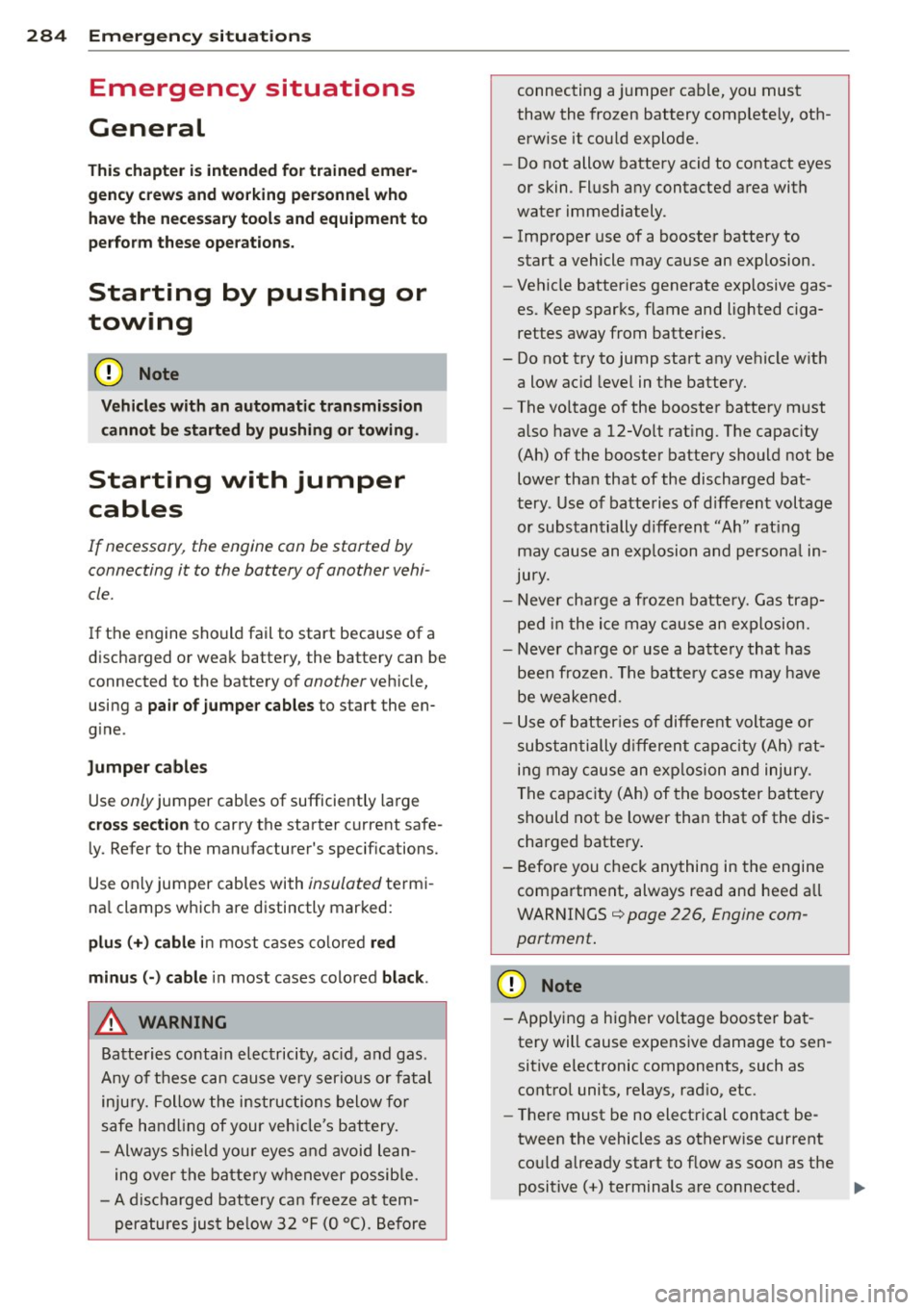
284 Emergency situations
Emergency situations
General
This chapter is intended for trained emer­
gency crews and working personnel who
have the necessary tools and equipment to
perform these ope rations.
Starting by pushing or
towing
Q;) Note
Vehicles with an automati c transmission
cannot be started by pushing or towing .
Starting with jumper
cables
If necessary, the engine can be started by
connecting it to the battery of another vehi­
cle.
If the engine should fail to start because of a
discharged or weak battery, the battery can be
connected to the battery of
another veh icle,
using a
pair of jumper cables to start the en­
g ine .
Jumper cables
Use only jumper cables of sufficiently large
cross section to carry the starter current safe­
ly. Refer to the manufacturer's specifications.
Use only jumper cables with
insulated termi­
na l clamps which are distinctly marked:
plus(+) cable in most cases colored red
minu s(-) cable
in most cases colored black .
A WARNING
Batteries contain electricity, ac id, and gas .
Any of these can cause very serious or fatal
inju ry. Follow the instructions below for
safe handling of your veh icle's battery.
- Always shield you r eyes and avoid lean­
ing over the battery whenever possible.
- A discharged battery can freeze at tem­
peratures just be low 32 ¬įF (0 ¬įC). Before connecting a
jumper cable, you must
thaw the frozen battery complete ly, oth­
erwise it could explode.
- Do not allow battery acid to contact eyes
or skin . Flush any contacted area with
water immediately .
- Improper use of a booster battery to start a vehicle may cause an explosion.
- Vehicle batteries generate explosive gas­
es. Keep sparks, flame and lighted ciga­
rettes away from batteries.
- Do not try to jump start any vehicle with a low ac id level in the battery.
- The vo ltage of the booster battery must
also have a 12-Volt rating . The capacity
(Ah) of the booster battery should not be
lower than that of the discharged bat­
tery . Use of batteries of d ifferent voltage
or substantially different "Ah" rating
may cause an exp losion and personal in­
jury.
- Never charge a frozen batte ry. Gas trap­
ped in the ice may cause an explosion.
- Never charge or use a battery that has
been frozen. The battery case may have
be weakened.
- Use of batter ies of different voltage or
substantially different capacity (Ah) rat­
ing may cause an exp losion and injury.
The capacity (Ah) of the booster battery
should not be lower than that of the dis ­
charged battery.
- Before you check anything in the engine
compartment, always read and heed a ll
WARNINGS ¬Ę
page 226, Engine com­
partment.
¬ęI) Note
-Applying a higher voltage booster bat­
tery will cause expensive damage to sen­
sitive electronic components, such as
contro l units, relays, rad io, etc .
- There must be no electrical contact be­
tween the vehicles as otherwise current
could already start to flow as soon as the
positive(+) terminals are connected. ..,_
Page 287 of 316
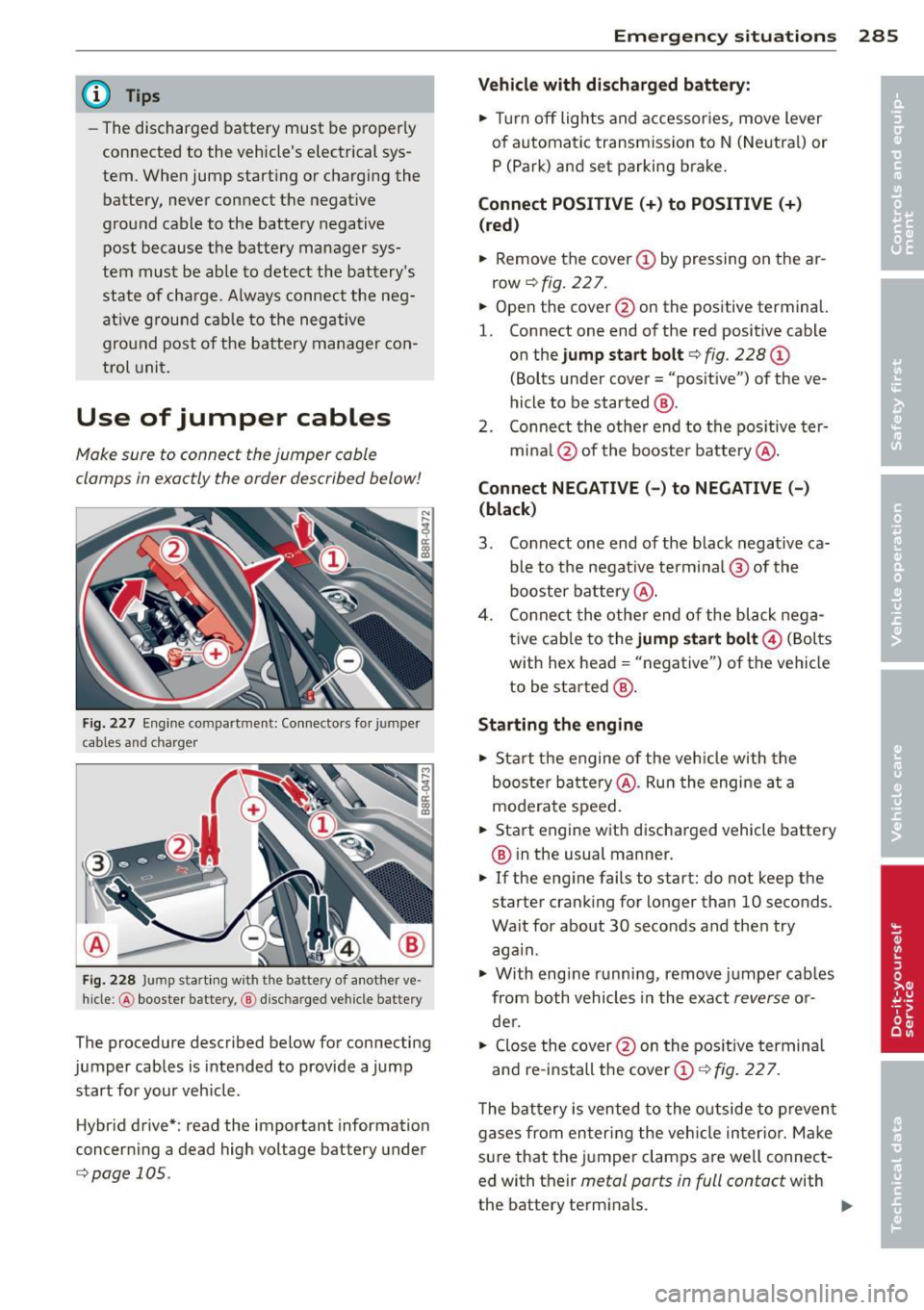
@ Tips
-The discharged battery must be properly
connected to the vehicle's electrical sys­
tem. When jump start ing or charging the
battery, never connect the negative
ground cable to the battery negative
post because the battery manager sys­
tem must be able to detect the battery's
state of cha rge . A lways connect the neg­
ative g round cab le to the negative
gro und post o f the battery manage r con­
trol uni t.
Use of jumper cables
Make sure to connect the jumper cobl e
clomps in exactly the order describ ed b elow!
Fig. 227 Engine co mpartmen t: Con ne ctors fo r jum per
c ables a nd char ger
Fi g. 22 8 Jump s tart in g w ith t he ba ttery of a not her ve ­
hi cle :@ booster battery, @ disc harged vehicle bat tery
The procedure described below for connecting
jumper cables is intended to provide a jump
start for your veh icle .
Hybr id drive*: read the important information
concerning a dead high voltage bat te ry under
c::;, page 105 .
Emergenc y situ ation s 285
Vehicle with discharged b attery:
.,. Turn off lights and accessor ies, move lever
o f automatic transmiss ion to N (Neutra l) or
P (Pa rk) and set parking brake.
Connect POSITIVE (+) to POSITIVE (+ )
(r ed)
.,. Remove the cover(!) by pressing on the ar­
row
¬Ę fig. 227.
.,. Open the cover @on th e positive terminal.
1. Connect one end of the red pos it ive cable
on the
jump start bolt c::;, fig. 228 (D
(Bolts under cover= "po sit ive") of the ve­
hicle to be started @.
2. Connect the othe r end to the pos itive ter-
mi na l@ of the booster battery @.
Connect NEGATIVE (-) to NEGATIVE (- )
(black )
3. Connect one end of the black negative ca­
ble to the negative termi na l@ of the
booster battery @.
4 . Co nnect the othe r end o f the black nega­
tive cab le to the
jump sta rt b olt © (Bolts
with hex head = "negative") of the vehicle
to be started @.
Starting the engine
.,. Start the engine of the veh icle w ith the
booster ba tte ry @ . Ru n the engine at a
moderate speed .
.,. Start eng ine wit h discha rged vehicle battery
@ in the usual manner .
.,. If the eng ine fails to start: do not keep the
starter crank ing for longer than 10 seconds.
Wait for about 30 seconds and then try
aga in .
.,. With engine running, remove jumper cab les
from both vehicles in the e xact
reverse o r­
de r .
.,. Close the cover @on the pos itive termina l
and re -install the cover
(D c::;, fig . 22 7.
T he battery is vented to the outside to preven t
gases from en ter ing the veh icle in ter io r. Ma ke
su re that the jumper clamps are well connect­
ed with their
metal parts in full contact with
the battery te rm inals.
Page 288 of 316
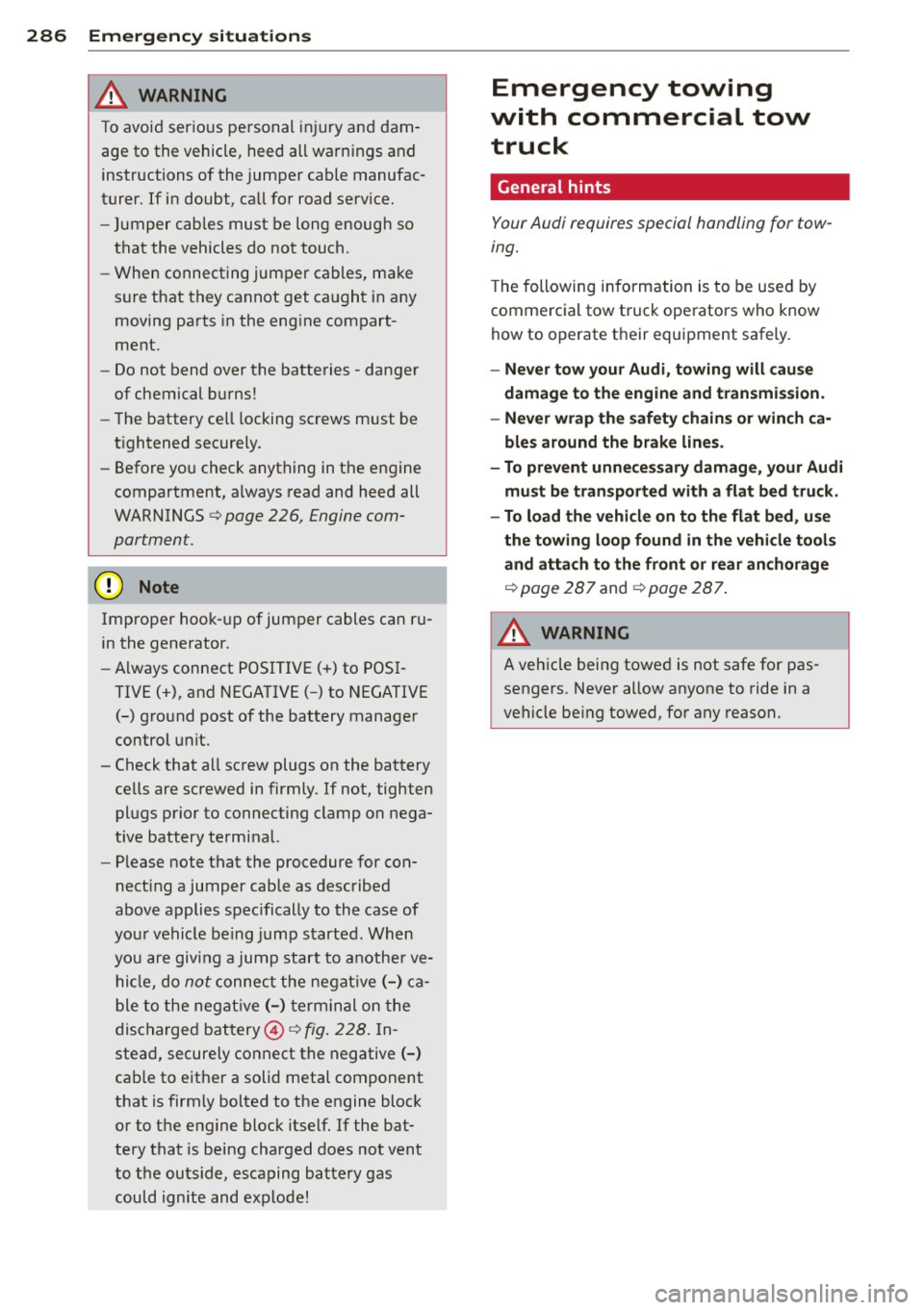
28 6 Em ergency sit uat ions
_& WARNING
To avoid serious personal injury and dam­
age to the vehicle, heed all warnings and
instructions of the jumper cable manufac­
turer. If in doubt, call for road serv ice.
- Jumper cables must be long enough so
that the vehicles do not touch.
- When connecting jumper cables, make
surethattheycannotgetca ughtinany
moving parts in the eng ine compart­
ment.
- Do not bend over the batteries -danger
of chemical burns!
- The battery cell locking screws must be
t ightened securely.
- Before you check anything in the engine
compartment, always read and heed all
WARNINGS
c:> page 226, Engine com­
partment .
Improper hook-up of jumper cables can ru­
in the generator.
- Always connect POSITIVE( +) to POS I­
TIVE(+), and NEGATIVE( -) to NEGATIVE
(-) ground post of the battery manager
control unit.
- Check that a ll screw plugs on the battery
cells are screwed in firmly . If not, tighten
plugs prior to connecting clamp on nega­
tive battery terminal.
- Please note that the procedure for con­
nect ing a jumper cable as described
above applies spec ifically to the case of
your vehicle being jump started. When
you are giving a jump start to anothe r ve­
hicle, do
not connect the negat ive (-) ca ­
ble to the negat ive (-) term inal on the
discharged bat tery ©
c:> fig. 2 28. In ­
stead, securely connect the negative(-)
cable to e ithe r a solid metal component
that is firm ly bolted to the engine block
or to the engine block itse lf. If the bat­
tery that is being charged does not vent
to the outside, escaping battery gas
could ignite and exp lode!
-
Emergency towing
with commercial tow
truck
General hints
Your Audi requires special handling for tow­
ing.
T he following information is to be used by
commercial tow truck operators who know
how to op erate their equipment safely.
- Nev er tow your Audi , towing will cau se
damage to the engine and tr an smi ssion .
- Ne ver wrap th e safety chain s or winch ca­
ble s around the brak e lines.
- To pre vent unne ce ss ary damage, your Audi
mus t be tr an sp o rt ed with a flat bed tru ck.
- To load th e vehi cle on to th e flat b ed, use
the towing l oop found in the ve hicle to ols
an d att ach to th e front or r ea r a ncho rage
c:>page 287 and Qpage 287.
_& WARNING
= -
A vehicle being towed is not safe for pas­
sengers. Never allow anyone to ride in a
vehicle being towed, for any reason.
Page 289 of 316
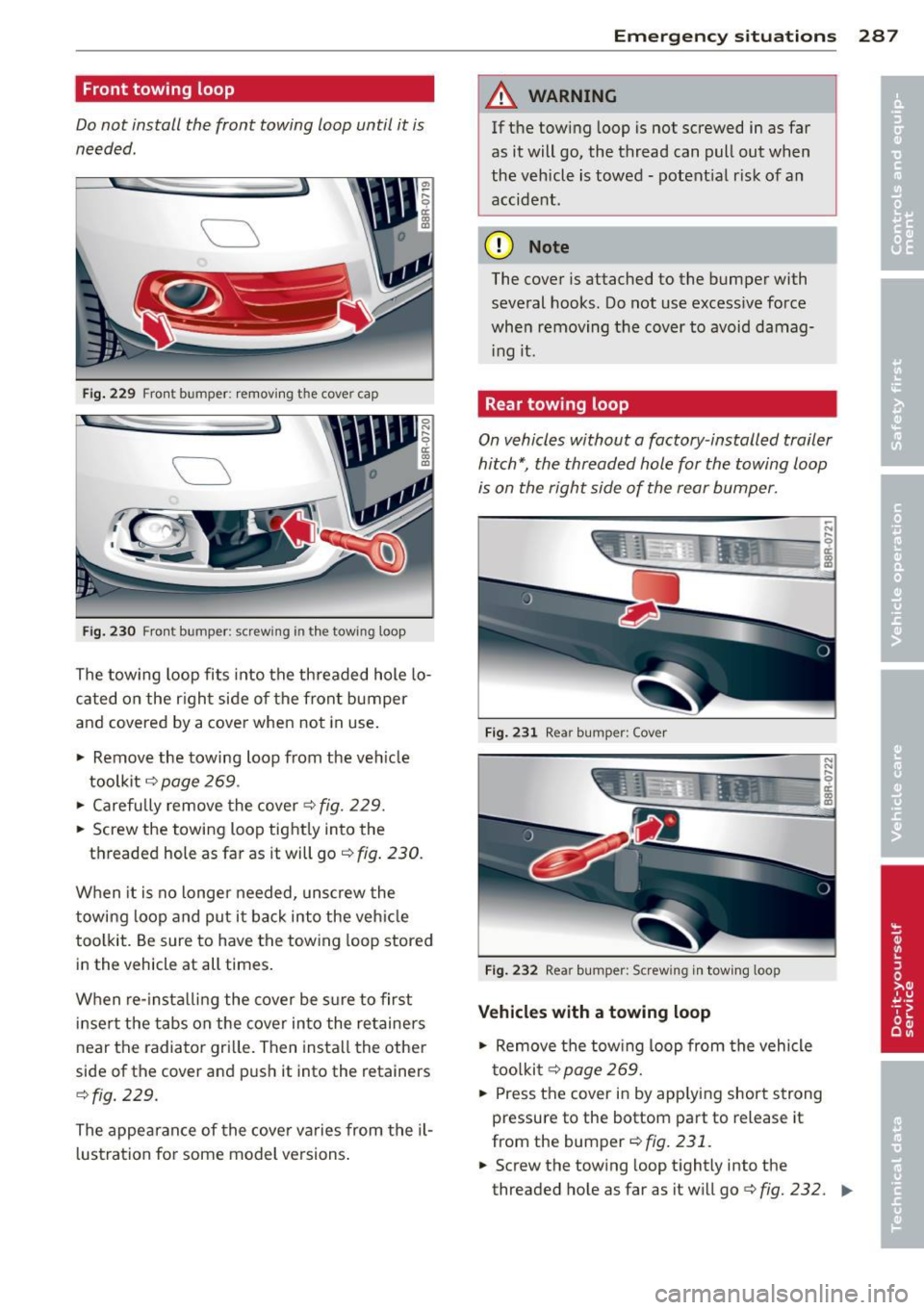
Front towing loop
Do not install the front towing loop until it is
needed.
Fig. 229 Fro nt bumper : removing the cover cap
Fig. 230 Front bumper: screwing in the towing loop
The towing loop fits into the th readed hole lo­
cated on the r igh t side of the fron t bumper
and covered by a cove r when not in use.
"' Remove the towing loop from the veh icle
toolkit
c:::> page 269.
"' Carefu lly remove the cover
c:::>fig. 229.
"' Screw the towing loop tightly into the
threaded hole as far as it will go
c:::> fig. 230.
When it is no longer needed, unscrew the
towing loop and put it back into the veh icle
too lkit. Be sure to have the towing loop stored
in the vehicle at all times.
When re- insta llin g the cover be s ure to first
i nse rt the tabs on the cover in to the retainers
near the radiator gri lle. Then install the other
side of the cover and p ush it into the retainers
c:::> fig . 229.
The appearance of the cove r va ries from the il­
l ustration fo r some model versions .
Emergenc y situ ation s 287
A WARNING
If the tow ing loop is not screwed in as far
as it will go, the thread can pull out when
the vehicle is towed -potent ia l risk of an
accide nt.
(D Note
The cover is attached to the bumper with
several hooks. Do not use excess ive force
when removing t he cover to avoid damag­
i ng it.
Rear towing loop
On vehicles without a factory-installed trailer
hitch*, the threaded hole for the towing loop
is on the right side of the rear bumper.
Fi g. 231 Rear b umper: Cover
N N .... -- o
!
Fig . 232 Rear bumper: Screwing in tow ing loop
V ehicles with a towing loop
"' Remove the tow ing loop from the vehicle
t oo lki t
c:::> page 269.
"' Press the cover in by app lying short strong
pressure to the bottom part to release it
from the bumper
c:!) fig. 231.
"' Screw the tow ing loop t ightly into the
threaded hole as far as it w ill go
¬Ę fig. 232. ..,.
Page 290 of 316
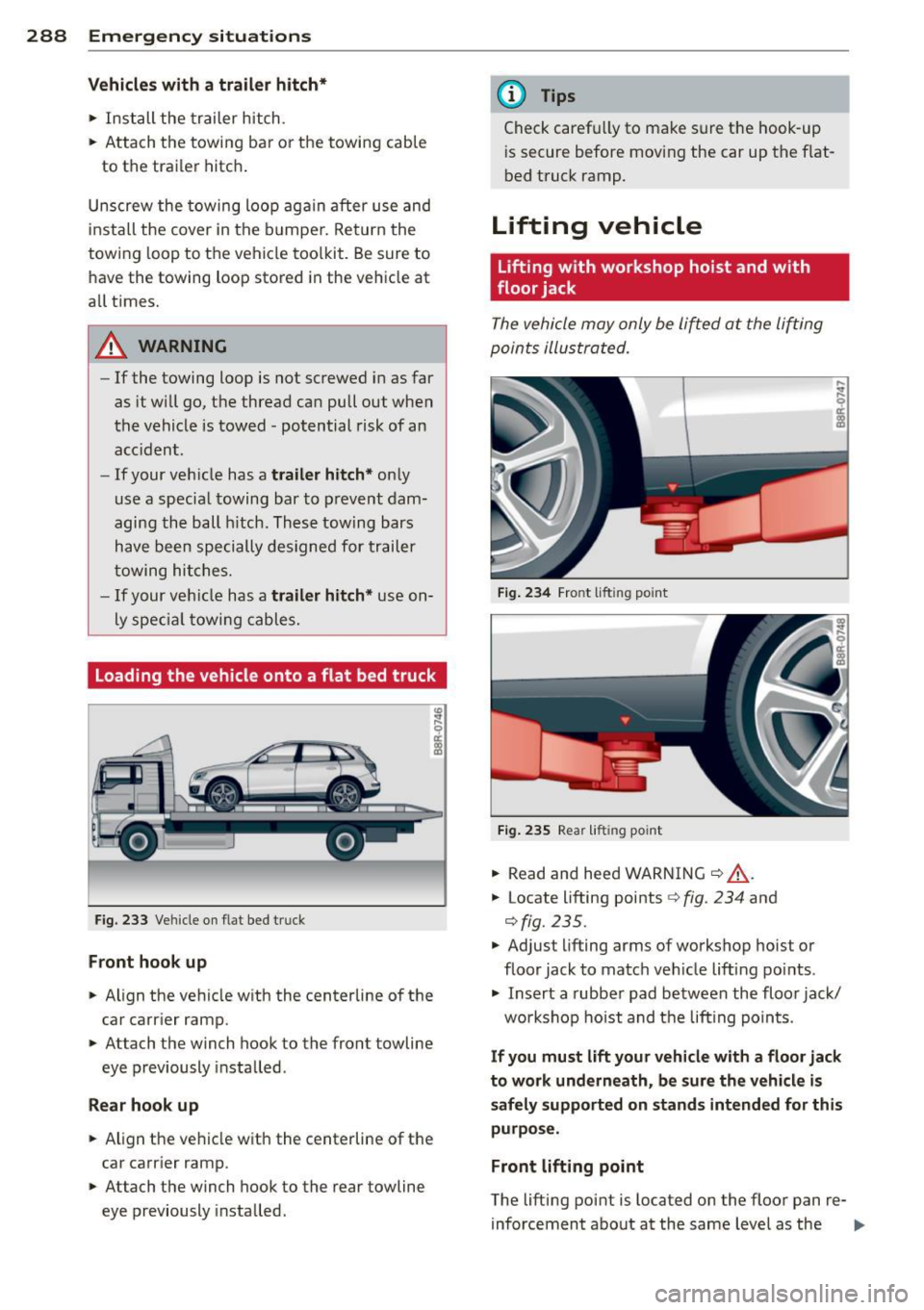
288 Emergency situations
Vehicles with a trailer hitch*
.,. Install the trailer hitch .
.,. Attach the towing bar o r the towing cab le
to the trai ler hitc h.
Unscrew the towing loop again a fter use and
i nstall the cover in the b umpe r. Re tur n the
towing loop to t he vehicle too lk it . Be sure to
have the towing loop stored in the vehicle at
a ll t imes.
A WARNING
- If the towing loop is not screwed in as far
as it will go, t he thread ca n pull out when
the vehicle is towed - potential risk of an acc ident .
- If your veh icle has a
trailer hitch* on ly
use a specia l towing bar to p revent dam ­
aging the ball h itch . Th ese towing bars
have been specially designed for trailer
t owing hitches.
- If your veh icle has a
trailer hitch* use on­
ly specia l towing cables .
Loading the vehicle onto a flat bed truck
Fig. 2 33 Veh icle on flat bed truck
F ront hook up
.,. Align the vehicle w ith the centerline of the
car carrier ramp .
.,. Atta ch the winch hook to the front towline
eye previously insta lled .
Rear hook up
.,. Align the ve hicle with the centerline of the
car carr ier ramp .
.,. Attach the winch hook to the rear towline
eye previously installed .
(D Tips
Check caref ully to make sure t he hook -up
i s secure before mov ing the car up the f lat­
b ed truck ramp .
Lifting vehicle
Lifting with workshop hoist and with
floor jack
The vehicle may only be lifted at the lif ting
points illustr ated.
Fig. 2 34 Fro nt li ftin g point
Fig . 2 3 5 Rea r liftin g po int
.,. Read and heed WARNING c::> .&._ .
.,. Locate lifting points c::> fig . 234 and
<=:>fig. 235 .
.,. Adjust lifting arms of workshop hoist o r
floor jack to matc h ve hicle lift ing po ints .
.,. Insert a rubbe r pad b etween the floo r jack/
workshop hoist and t he lift ing poin ts.
If you must lift your vehicle with a floor jack
to work undern eath, be sure the vehicle is
safely supported on stand s intended for this
purpo se .
Front lifting point
The lifting poi nt is located on the floor pan re-
inforcement abo ut at the same level as the
II>